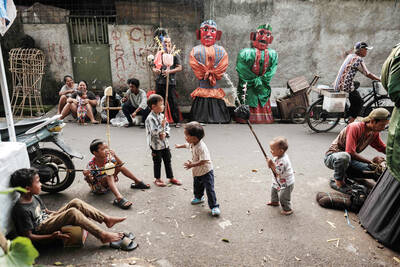The yellow-green streaks of fireflies that bring a magical air to summer nights, inspire camp songs and often end up in jars in children’s bedrooms may be flickering out in the backyards of the US as suburban sprawl encroaches on their habitats.
Scientists concerned by reports from the public that they are seeing fewer of the luminous insects each summer have turned to a network of backyard volunteers spanning much of the nation to track their range and numbers.
The Firefly Watch volunteers’ work is winding down now that the insects’ annual light show is over in all but southern states.
Helen Mester of South Bend, Indiana, is one of about 700 volunteers who entered observations this summer of firefly numbers, the color of their lights and flash patterns into the online database maintained by Firefly Watch, which is sponsored by the Boston Museum of Science.
The 54-year-old retiree has counted fireflies for three years for the program from her living room window or her deck.
About 200 firefly species found east of the Rocky Mountains produce, through a complex chemical reaction, lights ranging from yellow-green and yellow-amber to a pale blue. Light-producing fireflies aren’t found west of the Rockies.
Since the online Firefly Watch debuted in May 2008, about 5,100 people from 42 states have entered firefly data they collected in their yards, local parks and meadows, said Paul Fontaine, the Boston museum’s vice president of education.
Fontaine said the museum is committed to operating the program and database for at least 10 years to provide a year-to-year snapshot of firefly distribution.
The program, which also has volunteers in Canada, Costa Rica, Ghana and India, asks participants to watch fireflies for at least 10 minutes each week. Scientists at Massachusetts’ Fitchburg State University and Tufts University are helping with the project.
The data accumulating in the Firefly Watch database may help determine if fireflies are really declining, and if so where it’s happening and what could be causing it, said Christopher Cratsley, a Fitchburg biology professor who studies fireflies.
Cratsley said replacing meadows and fields with strip malls and parking lots clearly cuts firefly numbers. There is also evidence that the glare of streetlights that come with urban sprawl may interfere with the courtship of some firefly species by washing out their flashes.
He said pesticides, fertilizers and other chemicals could also kill the creatures that firefly larvae feed on, but the extent of that impact is unclear.
Georgia Southern University firefly researcher Jonathan Copeland believes the survey’s main contribution will be helping to pin down firefly species’ distribution. He said the question of whether firefly numbers were shrinking could only be answered by intensive study of specific locations over decades.
“The main value is if they are occurring and where they’re occurring,” said Copeland, a professor of biology.
San Antonio resident Denise Gregoire, who isn’t a Firefly Watch participant, lives in the same home where as a child she chased fireflies with friends. Nearly four decades after her parents moved to the home, the summer nights around it are devoid of fireflies.
Gregoire blames development — apartments, houses, a hospital complex — that replaced the fields that once surrounded her home, and the bright security lights that came with it.
“How are they going to eat, how are they going to survive, if all you’ve got is concrete?” said Gregoire, 48. “I guess they were decimated, because I don’t see them anymore.”
However, far from development, Firefly Watch observers like Steve Irvine still enjoy dazzling firefly displays.
Irvine, 57, has lived for more than three decades in a rural area of Ontario about 250km north of Toronto filled with fields and marshes. It’s a feast for firefly lovers.
Summertime visitors can step outside just after dusk and find themselves surrounded by tens of thousands of fireflies, blinking greenish-gold to a flickering orange.
“The fields around here are just alive with sparking light — it’s just magic. There’s countless thousands of them in the air. It’s just amazing,” Irvine said.

In the sweltering streets of Jakarta, buskers carry towering, hollow puppets and pass around a bucket for donations. Now, they fear becoming outlaws. City authorities said they would crack down on use of the sacred ondel-ondel puppets, which can stand as tall as a truck, and they are drafting legislation to remove what they view as a street nuisance. Performances featuring the puppets — originally used by Jakarta’s Betawi people to ward off evil spirits — would be allowed only at set events. The ban could leave many ondel-ondel buskers in Jakarta jobless. “I am confused and anxious. I fear getting raided or even

Kemal Ozdemir looked up at the bare peaks of Mount Cilo in Turkey’s Kurdish majority southeast. “There were glaciers 10 years ago,” he recalled under a cloudless sky. A mountain guide for 15 years, Ozdemir then turned toward the torrent carrying dozens of blocks of ice below a slope covered with grass and rocks — a sign of glacier loss being exacerbated by global warming. “You can see that there are quite a few pieces of glacier in the water right now ... the reason why the waterfalls flow lushly actually shows us how fast the ice is melting,” he said.

Eleven people, including a former minister, were arrested in Serbia on Friday over a train station disaster in which 16 people died. The concrete canopy of the newly renovated station in the northern city of Novi Sad collapsed on Nov. 1, 2024 in a disaster widely blamed on corruption and poor oversight. It sparked a wave of student-led protests and led to the resignation of then-Serbian prime minister Milos Vucevic and the fall of his government. The public prosecutor’s office in Novi Sad opened an investigation into the accident and deaths. In February, the public prosecutor’s office for organized crime opened another probe into

RISING RACISM: A Japanese group called on China to assure safety in the country, while the Chinese embassy in Tokyo urged action against a ‘surge in xenophobia’ A Japanese woman living in China was attacked and injured by a man in a subway station in Suzhou, China, Japanese media said, hours after two Chinese men were seriously injured in violence in Tokyo. The attacks on Thursday raised concern about xenophobic sentiment in China and Japan that have been blamed for assaults in both countries. It was the third attack involving Japanese living in China since last year. In the two previous cases in China, Chinese authorities have insisted they were isolated incidents. Japanese broadcaster NHK did not identify the woman injured in Suzhou by name, but, citing the Japanese